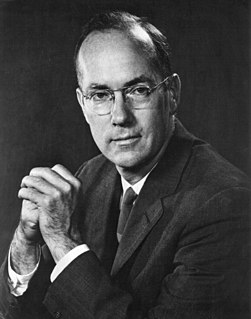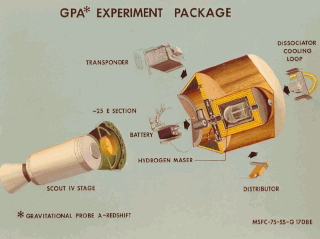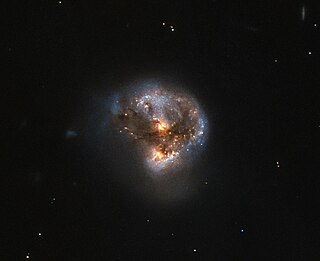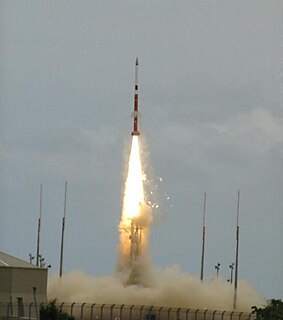See also
| This disambiguation page lists articles associated with the title Maser. If an internal link led you here, you may wish to change the link to point directly to the intended article. |
A maser is a device that produces coherent electromagnetic waves.
Maser may also refer to:
| This disambiguation page lists articles associated with the title Maser. If an internal link led you here, you may wish to change the link to point directly to the intended article. |

A maser is a device that produces coherent electromagnetic waves through amplification by stimulated emission. The first maser was built by Charles H. Townes, James P. Gordon, and Herbert J. Zeiger at Columbia University in 1953. Townes, Nikolay Basov and Alexander Prokhorov were awarded the 1964 Nobel Prize in Physics for theoretical work leading to the maser. Masers are used as the timekeeping device in atomic clocks, and as extremely low-noise microwave amplifiers in radio telescopes and deep space spacecraft communication ground stations.
Beam-powered propulsion, also known as directed energy propulsion, is a class of aircraft or spacecraft propulsion that uses energy beamed to the spacecraft from a remote power plant to provide energy. The beam is typically either a microwave or a laser beam and it is either pulsed or continuous. A continuous beam lends itself to thermal rockets, photonic thrusters and light sails, whereas a pulsed beam lends itself to ablative thrusters and pulse detonation engines.
For an electromagnetic wave, the coherence time is the time over which a propagating wave may be considered coherent, meaning that its phase is, on average, predictable.

A frequency standard is a stable oscillator used for frequency calibration or reference. A frequency standard generates a fundamental frequency with a high degree of accuracy and precision. Harmonics of this fundamental frequency are used to provide reference points.

A sounding rocket, sometimes called a research rocket, is an instrument-carrying rocket designed to take measurements and perform scientific experiments during its sub-orbital flight. The rockets are used to carry instruments from 48 to 145 km above the surface of the Earth, the altitude generally between weather balloons and satellites; the maximum altitude for balloons is about 40 km and the minimum for satellites is approximately 121 km. Certain sounding rockets have an apogee between 1,000 and 1,500 km, such as the Black Brant X and XII, which is the maximum apogee of their class. Sounding rockets often use military surplus rocket motors. NASA routinely flies the Terrier Mk 70 boosted Improved Orion, lifting 270–450-kg (600–1,000-pound) payloads into the exoatmospheric region between 97 and 201 km.

Charles Hard Townes was an American physicist. Townes worked on the theory and application of the maser, for which he obtained the fundamental patent, and other work in quantum electronics associated with both maser and laser devices. He shared the 1964 Nobel Prize in Physics with Nikolay Basov and Alexander Prokhorov. Townes was an adviser to the United States Government, meeting every US President from Harry Truman (1945) to Bill Clinton (1999).

Gravity Probe A (GP-A) was a space-based experiment to test the equivalence principle, a feature of Einstein's theory of relativity. It was performed jointly by the Smithsonian Astrophysical Observatory and the National Aeronautics and Space Administration. The experiment sent a hydrogen maser—a highly accurate frequency standard—into space to measure with high precision the rate at which time passes in a weaker gravitational field. Masses cause distortions in spacetime, which leads to the effects of length contraction and time dilation, both predicted results of Albert Einstein's theory of general relativity. Because of the bending of spacetime, an observer on Earth should measure a slower rate at which time passes than an observer that is higher in altitude. This effect is known as gravitational time dilation.

Esrange Space Center is a rocket range and research centre located about 40 kilometers east of the town of Kiruna in northern Sweden. It is a base for scientific research with high-altitude balloons, investigation of the aurora borealis, sounding rocket launches, and satellite tracking, among other things. Located 200 km north of the Arctic Circle and surrounded by a vast wilderness, its geographic location is ideal for many of these purposes.

The Swedish Space Corporation (SSC) is a comprehensive space company that has 40 years of experience in helping space organizations, companies and research organizations with access to space.

Ali Javan was an Iranian-American physicist and inventor. He was the first to propose the concept of the gas laser in 1959 at the Bell Telephone Laboratories. A successful prototype, constructed by him in collaboration with W. R. Bennett, Jr., and D. R. Herriott was demonstrated in 1960. His other contributions to science have been in the fields of quantum physics and spectroscopy.

An astrophysical maser is a naturally occurring source of stimulated spectral line emission, typically in the microwave portion of the electromagnetic spectrum. This emission may arise in molecular clouds, comets, planetary atmospheres, stellar atmospheres, or various other conditions in interstellar space.

A megamaser is a type of astrophysical maser, which is a naturally occurring source of stimulated spectral line emission. Megamasers are distinguished from astrophysical masers by their large isotropic luminosity. Megamasers have typical luminosities of 103 solar luminosities (L☉), which is 100 million times brighter than masers in the Milky Way, hence the prefix mega. Likewise, the term kilomaser is used to describe masers outside the Milky Way that have luminosities of order L☉, or thousands of times stronger than the average maser in the Milky Way, gigamaser is used to describe masers billions of times stronger than the average maser in the Milky Way, and extragalactic maser encompasses all masers found outside the Milky Way. Most known extragalactic masers are megamasers, and the majority of megamasers are hydroxyl (OH) megamasers, meaning the spectral line being amplified is one due to a transition in the hydroxyl molecule. There are known megamasers for three other molecules: water (H2O), formaldehyde (H2CO), and methine (CH).

Maser is a comune (municipality) in the Province of Treviso in the Italian region Veneto, located about 50 kilometres (31 mi) northwest of Venice and about 25 kilometres (16 mi) northwest of Treviso. As of 31 December 2004, it had a population of 4,854 and an area of 26.0 square kilometres (10.0 sq mi).

VSB-30 - "Veículo de Sondagem Booster – 30" or "Foguete Suborbital VSB-30" is the designation of a Brazilian sounding rocket, which replaced the Skylark rocket at Esrange.
Jean-Marie Loret was a French railway worker and allegedly Adolf Hitler's illegitimate son. According to Loret, in 1948 his mother revealed to him shortly before her death that the "unknown German soldier" with whom she'd had an affair during World War I was Adolf Hitler.
Radiophysics is a branch of physics focused on the theoretical and experimental study of certain kinds of radiation, its emission, propagation and interaction with matter.
Dr. Henry Evelyn Derrick Scovil, better known as H. E. D. Scovil or Derrick Scovil, is a physicist noted for his contributions to masers and bubble memory.

Maxus is a sounding rocket that are used in the MAXUS microgravity rocket programme, a joint venture between Swedish Space Corporation and EADS Astrium Space Transportation used by ESA. It is launched from Esrange Space Center in Sweden and provides access to microgravity for up to 14 minutes.
TEXUS is a European/German sounding rocket programme, serving the microgravity programmes of ESA and DLR. The launches are conducted from Esrange in Sweden.
MASER is a sounding rocket that is used in the MASER microgravity research rocket programme, which is operated by the Swedish Space Corporation (SSC). The main customer is the European Space Agency (ESA), and in particular its EMIR and ELIPS programmes. MASER stands for "MAterials Science Experiment Rocket".